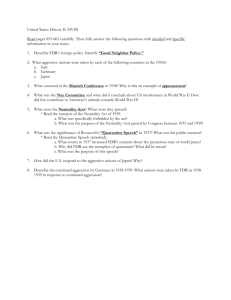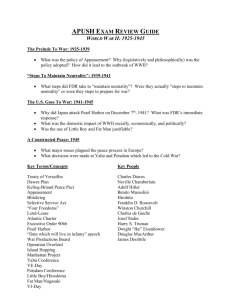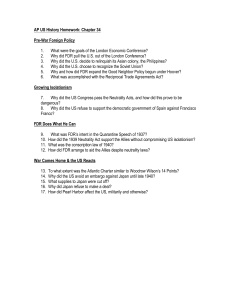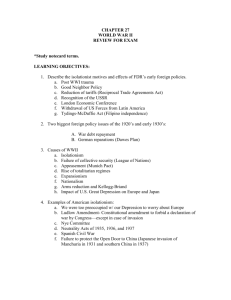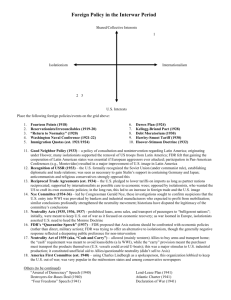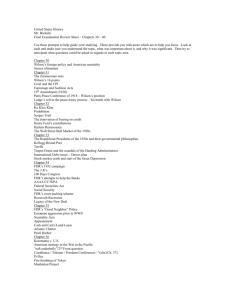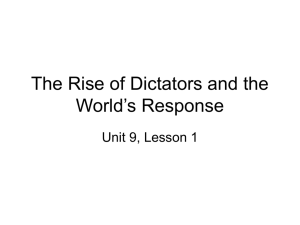Diplomacy and World War II
advertisement
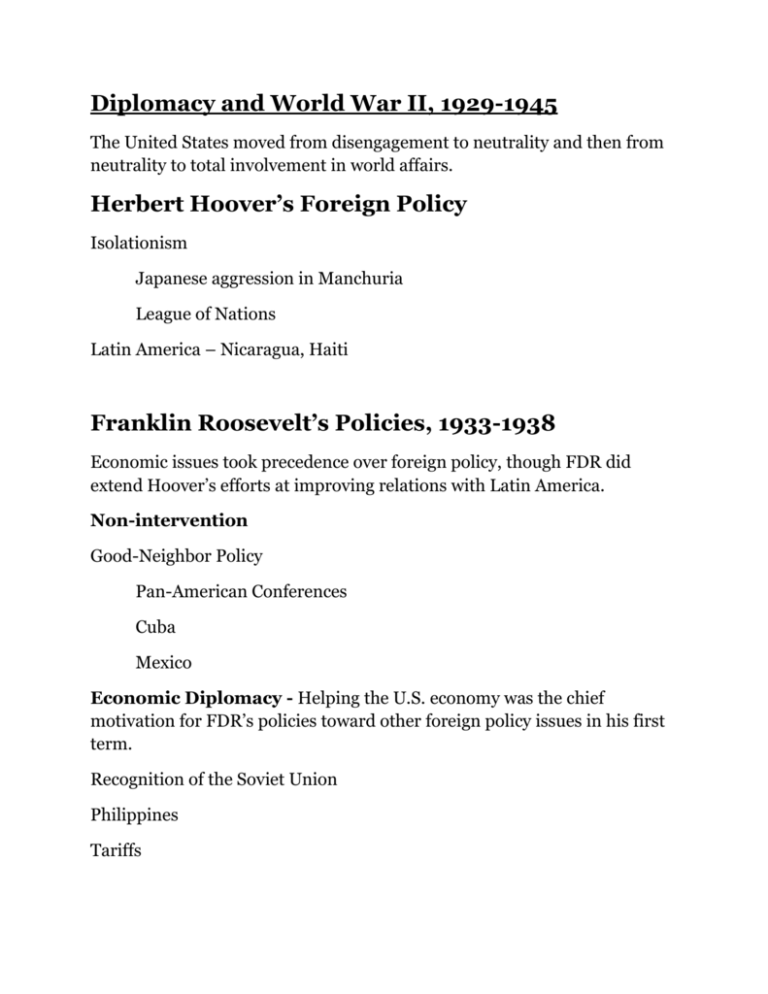
Diplomacy and World War II, 1929-1945 The United States moved from disengagement to neutrality and then from neutrality to total involvement in world affairs. Herbert Hoover’s Foreign Policy Isolationism Japanese aggression in Manchuria League of Nations Latin America – Nicaragua, Haiti Franklin Roosevelt’s Policies, 1933-1938 Economic issues took precedence over foreign policy, though FDR did extend Hoover’s efforts at improving relations with Latin America. Non-intervention Good-Neighbor Policy Pan-American Conferences Cuba Mexico Economic Diplomacy - Helping the U.S. economy was the chief motivation for FDR’s policies toward other foreign policy issues in his first term. Recognition of the Soviet Union Philippines Tariffs Events Abroad: Fascism & Aggressive Militarism - The worldwide depression soon proved to have alarming repercussions for world politics. Combined with nationalist resentments after WWI, economic hardships gave rise to military dictatorships in Italy in the 1920s and Japan and Germany in the 1930s. Fascism Italy Germany Japan American Isolationists - The U.S. was also nationalistic, but expressed itself in an opposite way as isolationists sought to avoid being drawn into a foreign war at all costs. Nye Committee Neutrality Acts America First Committee Prelude to War - In the years 1935 to 1938, a series of aggressive actions by the Fascist dictatorships made the democratic governments in Britain and France extremely nervous. Hoping to avoid open conflict with Germany, the democracies adopted a policy of appeasement. The U.S. went along with this policy. Appeasement Ethiopia, 1935 Rhineland, 1936 China, 1937 Sudetenland, 1938 U.S. Response Quarantine speech Preparedness From Neutrality to War, 1939-1941 In March 1939, Hitler broke the Munich agreement. After this, it became clear that war was probably unavoidable. Outbreak of War in Europe Non-aggression Pact Invasion of Poland Blitzkrieg Changing U.S. Policy – While Americans were alarmed and opposed to Hitler, most still hoped to keep out of the war. FDR, however, believed that British survival was crucial to U.S. security, and therefore attempted to chip away at restrictive neutrality laws. “Cash and Carry” Selective Service Act Destroyers-for-bases Deal The Election of 1940 FDR Wendell Willkie Results Arsenal of Democracy – After his reelection, FDR believed he was in a stronger position to end the appearance of U.S. neutrality. Four Freedoms Lend-Lease Act Atlantic Charter Shoot-on-sight Disputes with Japan – Japan’s invasion of China and ambitions in Southeast Asia increasingly strained the relationship with the U.S. Axis Powers U.S. economic action Negotiations Pearl Harbor Partial surprise Declaration of war World War II: The Home Front Industrial Production Cost-plus system Results Wages, prices, and rationing Unions Smith-Connally Anti-Strike Act Financing The War’s Impact on Society Midwest-Pacific Coast/South African Americans 1.5/1 NAACP C.O.R.E. Mexican Americans 300K Native Americans 25K Japanese Americans 20K/100K Korematsu v. U.S. Women 200K Propaganda The Election of 1944 FDR World War II: The Battlefronts The fighting of WWII was waged on two fronts. In the Pacific, Japanese forces in 1942 reached the height of their power while in Europe much of the fighting in the first year was between the Germans and the Soviets. Fighting Germany Battle of the Atlantic Radar Sonar Operation Torch Dwight D. Eisenhower Italy D-Day Battle of the Bulge Surrender Holocaust Fighting Japan Battle of Coral Sea Battle of Midway Island-hopping Leyte Gulf Kamikaze Battle of Okinawa Atomic bombs Manhattan Project Robert Oppenheimer Hiroshima Nagasaki Surrender Wartime Conferences Yalta Death of FDR Potsdam The War’s Legacy Costs 300K United Nations Expectations 800K $320B $250B
